

How to Perform SEO Competitors’ Research
Whether you are looking for ways to increase product sales, prepare for a new market entry, or just want to make sure your clients find you online by working on SEO, the better prepared you are, the easier it is to act.
The same approach works perfectly well with any type of online marketing activities, including search engine optimisation. If you are well-prepared and have done good research first, you’ll have a very clear idea on what you should do next. Before you start with an SEO plan, there are three things you should do:
- SEO Keyword Research
- SEO Competitors Research
- SWOT Analysis
Let’s cover more about SEO Competitor Research in detail, as this particular step has a crucial role in preparing an SEO strategy.
What is competitor research?
Competitor research is an overview of the SEO activities that your competitors do. Ideally, it is a complete overview of ALL online marketing activities that your competitors do, including:
- SEO
- Content and email marketing
- Paid advertising
- Social media activity
At this stage, the main focus stays on SEO and content activities. For the rest – you need to discover only the basic things:
- Do they have online advertising?
- Are they active on social media?
Why should you conduct competitor research?
Every business can benefit from well-made competition research in many ways.
- Define the needs of the customer. It’s one of the quickest ways to confirm what the goals and needs of your customers are. It can help you discover market trends, develop new products and series, and utilise all marketing channels.
- Define a niche in the market. Well-done competition research will help you identify the right niche, and build a tone of voice to speak to your audience. It can help you find gaps in the market where your brand fits perfectly.
- Be aware of what your competitors do. Competition research also helps you keep your “enemies” close. The best way to make sure you’re doing everything better than other brands is to keep a close eye on their activities. Even if you come up with a totally new way to position your product or service, you need to make sure it is unique.
All this can help you create better marketing, SEO, and social media strategies.
Before diving into the topic, bear in mind that what works for a brand similar to your business does not necessarily mean it will work for your own brand. Always make sure that your product fits well with what your target audience wants, and be flexible to changes.
How to do SEO Competition Research?
When it comes to SEO competition research the first thing you need to take into consideration are the most important ranking factors:
- Content strategy
- Backlinks
- Website performance and design
- Domain authority
- Matching SEO Keywords and search intent
With over 10 years of experience in SEO and online marketing, we have established a solid 5-step plan to get an all-round competitor research.
Before you start, you might want to use the SEO Competitor research template we have prepared for you.
Just open it, make a copy and let all the fun begin!
Step 1. Define your competitors
Start by finding out who your direct competitors are.
Direct competitors are businesses who provide products and services which are similar to yours and based in the same location. An example of direct competitors is Netflix and HBO GO. Both companies provide subscription-based services and offer an online viewing experience for their audience.
Your indirect competitors are businesses that offer different solutions to the same problems of your target audience. An example of indirect competitors can be a pizza place and a burger restaurant. Both businesses satisfy the same customer needs but provide different products to do so.
When doing competition research for SEO purposes you should only focus on your direct competitors.
Your direct competitors are the websites that are competing together with you for the same positions in organic search with the same keywords.
Start by figuring out what your potential customers might search for to find your website.
Let’s have a look at a website from our own portfolio – ergoErgo
ErgoErgo sells ergonomic stools that combine the benefits of active sitting with a contemporary design.
According to the SEO keyword research we have done previously, it makes sense to check businesses who rank well for the best-performing keywords in our region. In our case it’s “ergonomic stools”.
To be more precise, you might want to look for “ergonomic stools+location”, or use an action-based long-tail keyword+location, like “ buy ergonomic stools in New York”.
For you the formula here will be:
“your primary keyword + action desired + location”.
Google will define a list of all your competitors.
On the first page, there are some retailer websites that pop up such as Amazon and Wayfair, some articles with product lists, and some relevant competitors that sell ergonomic stools and chairs.
Let’s start adding those websites to a spreadsheet.
To help you gather all the important information on competitor research, here’s the template of one we do ourselves, which you are welcome to copy and use.
We’re using the Ahrefs Keyword Explorer tool to identify whether people are actually searching for this term.
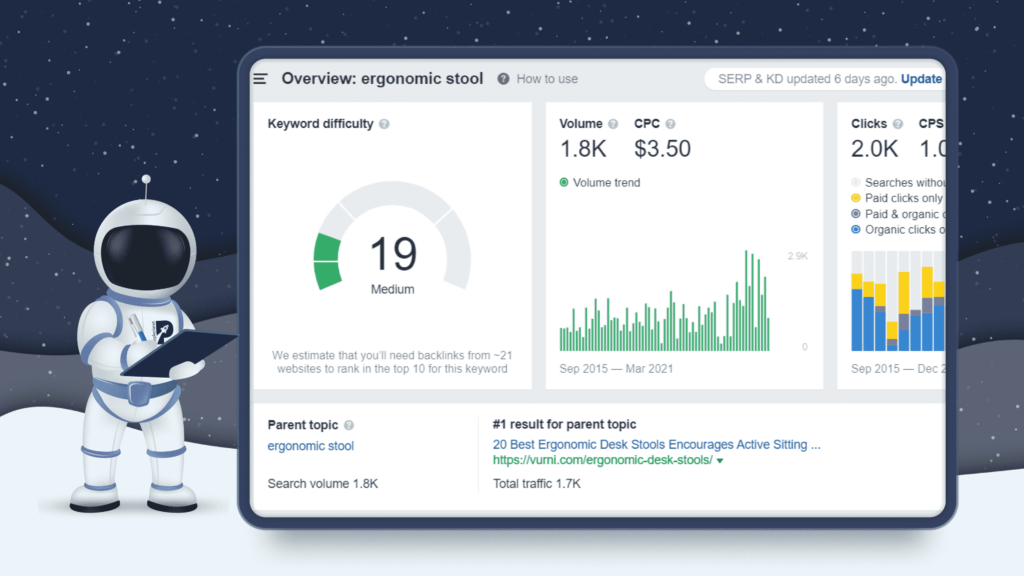
We see that the keyword has a great search volume, so we are on the right track.
From here, you can identify your competitors by analysing the search engine results page (SERP). You can get that information from the Keyword explorer tool as well.
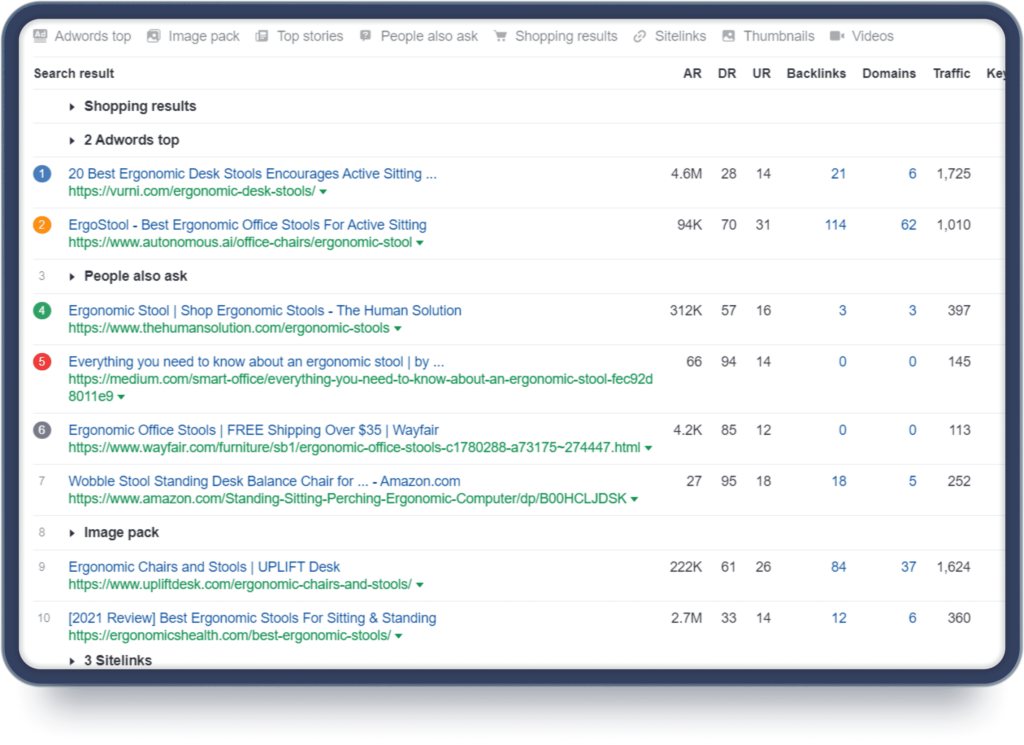
Тhe Ahrefs site explorer gives us almost the same results as the manual Google search we did – articles with product catalogs, marketplaces, bigger companies that sell ergonomic furniture in general (including ergonomic stools) but no companies that focus on selling ergonomic stools.
This is a great opportunity in terms of SEO! This simple keyword check showed that there are no companies that promote the same exact product as ours and that are focusing on the exact keywords. They target keywords such as “ergonomic chairs” or “ergonomic furniture”.
To do more in-depth keyword research you can use free SEO tools such as:
- Ubersuggest
- Google Keyword Planner
- Google Trends
- Answer the Public
or paid ones such as:
- Ahrefs Keyword Explorer
- Semrush Keyword Research Tool
- Moz Keyword Explorer
Let’s go further and enter the website URL into the Site Explorer tool. Go to the “Competing Domains” from the sidebar.
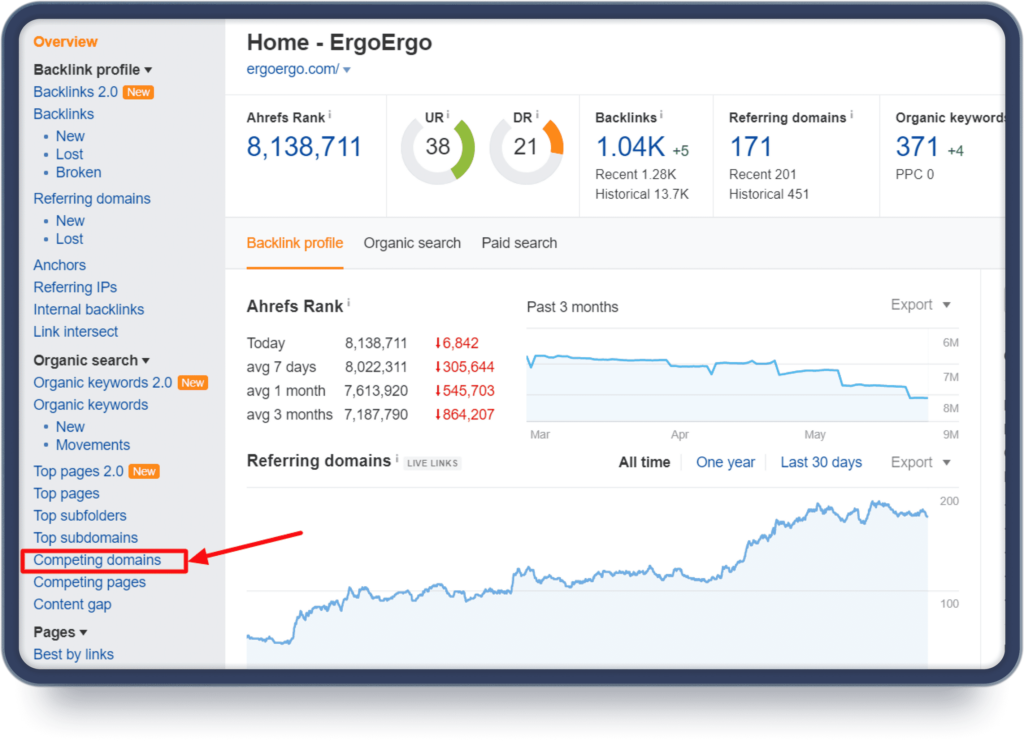 Here is the list with domains that Ahrefs identifies as our competing domains.
Here is the list with domains that Ahrefs identifies as our competing domains.
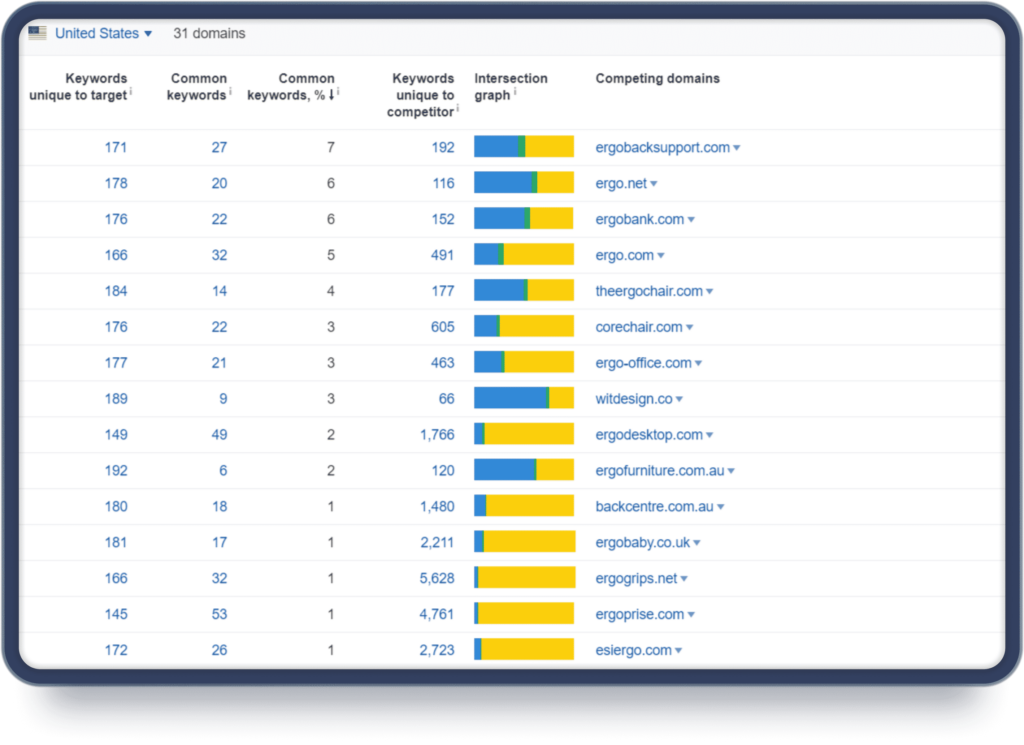
With further research, we can see that these websites are not relevant competitors to our website. Even though these websites are ranking for similar keywords to ours, almost no one is actually selling ergonomic stools.
Be careful when using this feature. Sometimes, the research might include irrelevant websites with similar brand names and website domains.
We’ll now use Ahrefs Site Explorer and gather general information such as DR, number of backlinks, organic traffic, organic keywords etc. We’ll write the results in our spreadsheet.
Make a note of the websites that perform the best in terms of SEO. This means that they pay attention to their online marketing. When analysing SEO strategies, focus on those websites.
Pro Tip: If you’re trying to find the competitors for an e-commerce website, or for a website that offers different products or services, it’s best to see which websites are ranking for all different products or services.
The market can shift and your main competitors can change. That’s why it’s important to keep an eye on your market regularly for new players or new tactics. We recommend doing competition research for your brand at least once a year.
Step 2. Analyse the organic keywords of your competitors
When you’re done with identifying your competitors, and you have a list of domains, analyse the competitor’s website for keywords they are ranking. This can help you get insight into the keyword strategy they use.
Since we didn’t find direct competitors in the SERP, we’ll check out websites selling ergonomic furniture and see which keywords they’re targeting in the ergonomic stools category.
We are using the Ahrefs Keyword Explorer filters to filter keywords with the word “stool” in them, but you can use any affordable tool such as Ubersuggest or Google keyword planner to do the keyword research and manually find the targeted keywords.
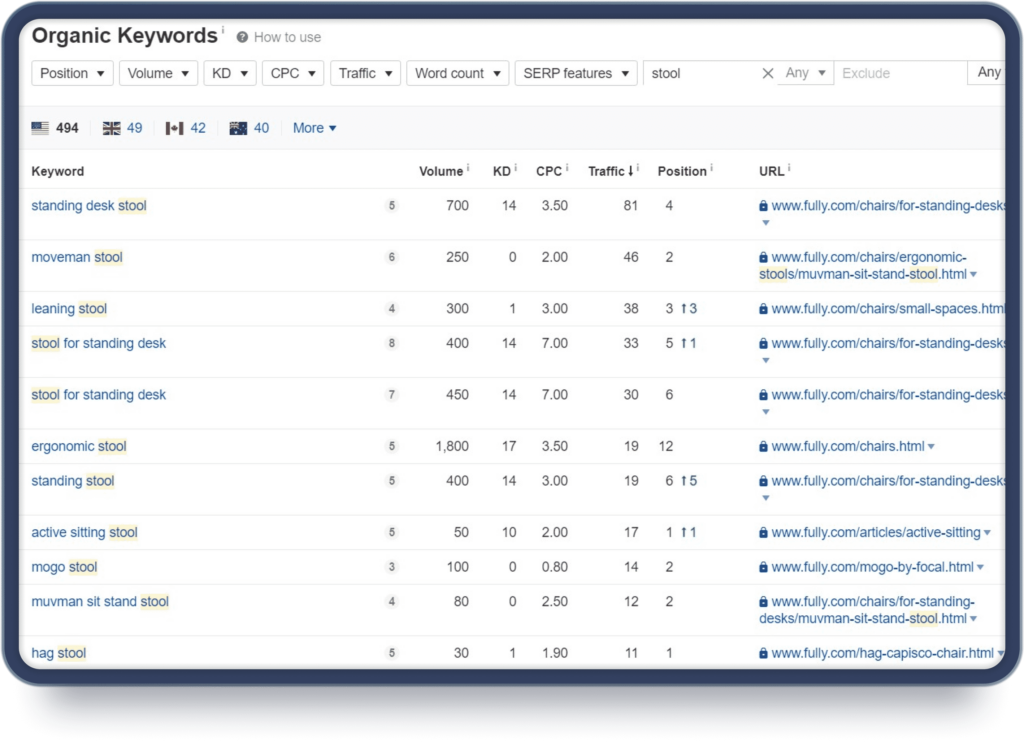
We analysed our competitors and added the relevant keywords they target in our spreadsheet.
When you’re done with the analysis, answer these questions:
- Which of these keywords can you target as well?
- Are those websites performing well in organic search or are they relying on ad campaigns?
- Are there relevant keywords that your competitors are not yet targeting?
Learn more on how to do proper keyword research.
Step 3. Analyse backlinks
After identifying organic keywords, it’s time to focus on the competitor’s link-building efforts.
Start by checking how often your competitors acquire a new link. You can do that in the backlinks explorer in Ahrefs. Enter the domain name in the site explorer bar and choose new referring domains from the sidebar.
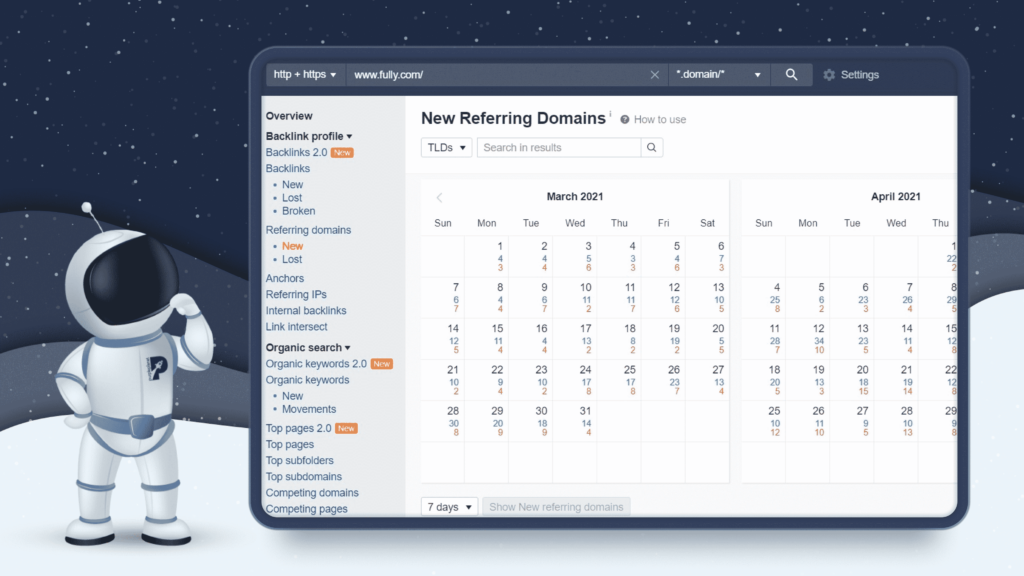
We can see that one of the main competitors fully.com acquires new backlinks from referring domains on a daily basis. For the last 90 days, the website has 2,187 new referring domains.
Let’s dive deeper into the competitor’s backlink profiles.
You can click on the backlinks option in the sidebar to analyse the type of backlinks your competitor has acquired.

You can see what the Domain Rate of the linking domains is, which anchors have been used, which types of websites are linking to the content, how many links there are from one domain, and more.
We did a quick analysis and wrote down the results in our spreadsheet. Feel free to dive deeper and understand how they acquire good links.
If you don’t have access to Ahrefs, you can use the free tool Ubersuggest.
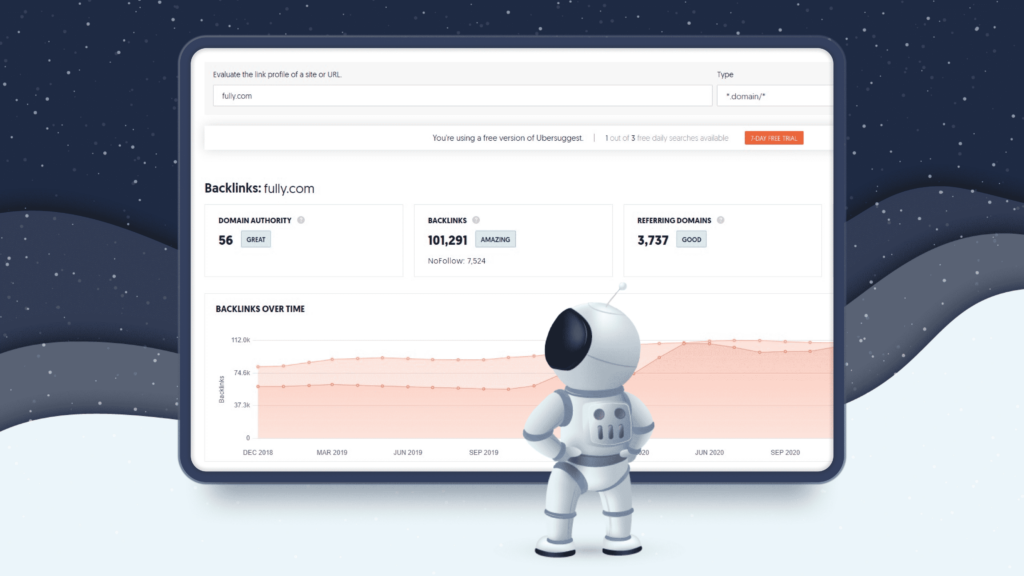
Step 4. Analyse competitor’s content efforts
When analysing the content of your competitors, start with keywords that your site does not yet rank for. This is called а content gap.
The Ahrefs tool has an amazing option where you can check multiple competitor domains and find keywords that they rank for but your brand still does not.
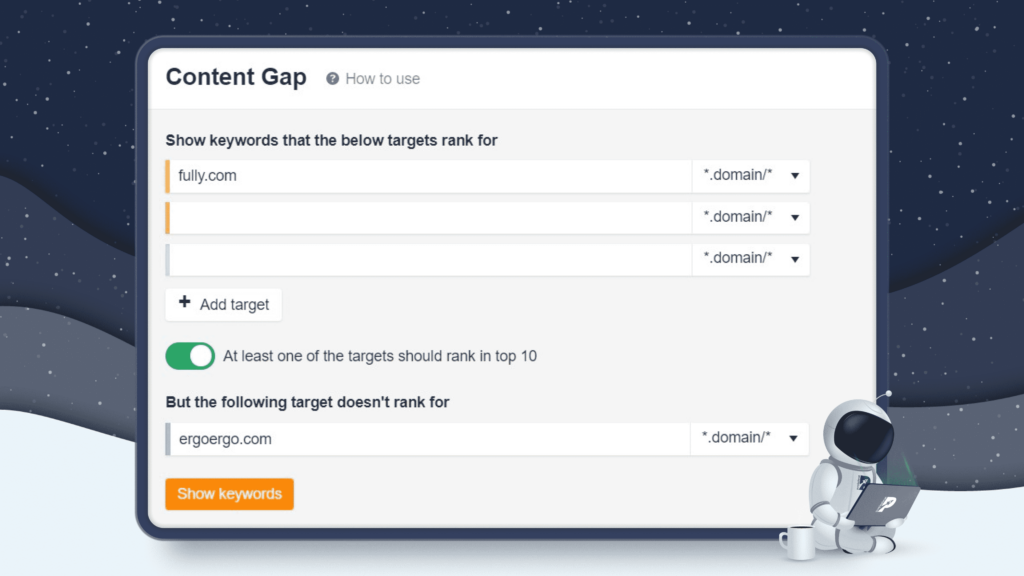
You can do that manually in a spreadsheet by going to the keyword research for each domain and noting keywords you find that you can rank for.
The next thing you can do is look into what type of content your competitors have on their websites. Let’s have a quick look and write that down in the spreadsheet.
Do they have a blog? Are they using the blog to rank on targeted keywords or are they writing content that is not intended for improving SEO? They can simply share customer stories, interviews, etc.
If they are targeting organic keywords with their blog post, find out whether you can “steal” those keywords by creating better content that answers all user questions when reading it.
If the website is for the purpose of selling goods or services, analyse their service pages as well. How well do these pages perform in the search engine? Do they manage to take a featured snippet? Do they contain a FAQ section? How well do they describe the services they offer?
Pay attention to the visual content they use as well. Are their images clean and minimal, or fun and bright? Do they use videos? Do they use illustration to better convey their messages? What about animation?
What can you do better to “steal” their ranking positions?
Step 5. Do a SWOT Analysis
After collecting and evaluating all important information, you can perform a simple SWOT analysis.
A SWOT analysis is a strategic research technique that can help you identify strengths, weaknesses, opportunities, and threats when it comes to business competition.
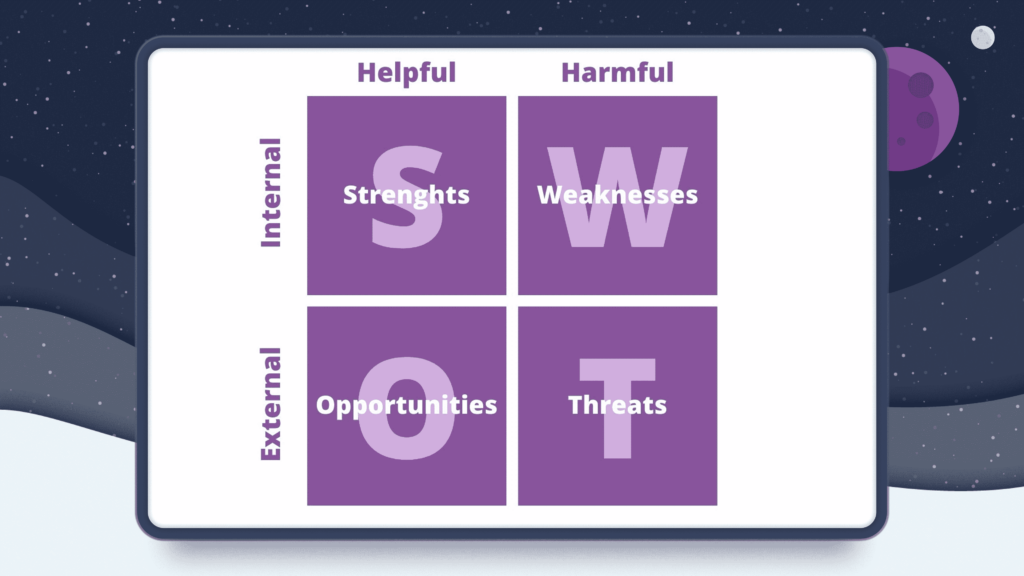
The SWOT analysis can help you answer such as:
What are the strengths of your competitors? What do they do really well? Is it social media marketing, content marketing, or sales?
- What are the weaknesses of your competitors?
- What makes your competitors better than your brand?
- What makes your brand better than the competitors’?
- Are there any opportunities that your competitors haven’t yet identified?
By using a SWOT analysis to identify the strength and weaknesses of your brand, and of your competitors’ brands, you can uncover areas of improvement that may never have been a part of your plans. Take the time to perform this analysis at least once per year, to stay on top of your industry.
Spending the time to do proper competition research can help you enhance your business strategies. Ignoring what your competitors are doing might have a negative effect. You might miss opportunities to “steal” the attention from them and direct it to your brand.











